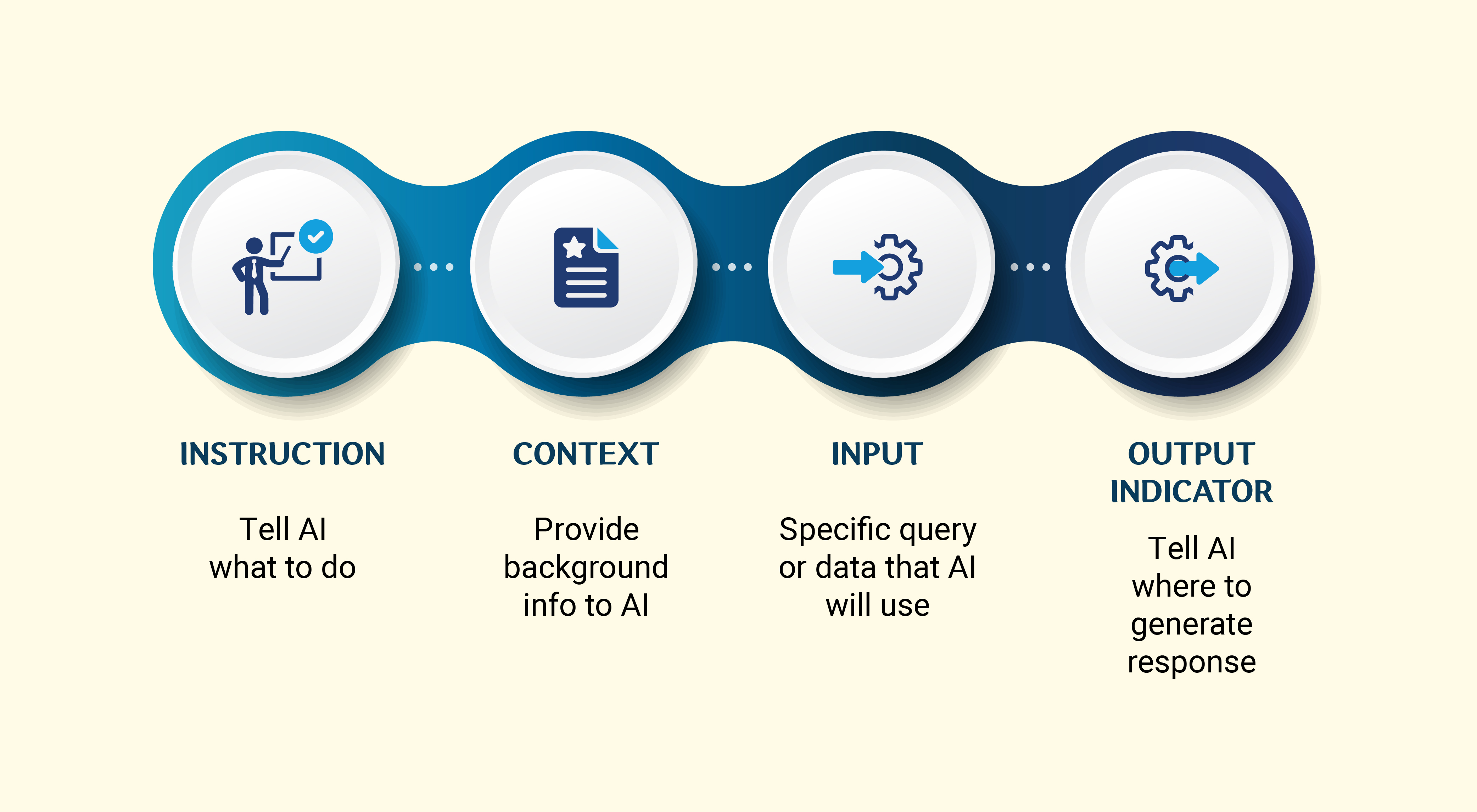In the field of artificial intelligence, generative AI models like GPT (Generative Pre-trained Transformer) have become more and more popular over the years. These models can produce text that is very similar to what humans write. To effectively communicate with these models, it's important to understand the concept of "prompt engineering." Let's simplify this concept and explore why it's important.
What is a prompt?
In generative AI, a prompt is like a question or instruction for the AI model. It's similar to asking your smart assistant to remind you about a friend's birthday or to summarize a news article. The prompt is what you give, and the AI's response is what you get back.
What is prompt engineering?
Prompt engineering is the art and science of creating prompts that guide an AI model to produce the desired output. It involves asking questions in a way that helps the AI generate useful and accurate responses, rather than just asking any questions.
Importance of prompt engineering
Here's why prompt engineering is important:
- Efficiency: Proper prompt engineering helps in getting the desired answer more efficiently, reducing the need for follow-up questions.
- Accuracy: It improves the accuracy of the responses from the AI, as the prompts guide the model in understanding the context better.
- Customization: It allows for tailored responses based on specific needs or context, enhancing the user experience.
Building blocks of effective prompts
Given below are the building blocks to create effective prompts.
- Instruction: This is the directive given to the AI, telling it what to do. For instance, "Explain," "Describe," or "List."
- Context: This provides background information that helps the AI understand the setting or specifics of the task. For example, providing contextual data from the specification.
- Input: This is the specific user query or data that the AI will use to generate its response.
- Output indicator: This tells the AI where to begin generating its response, ensuring clarity in multi-turn dialogues.

Example – Generated exhaustive test cases for a login page
Let’s break down the prompt using structured building blocks to ensure a well-defined output.
Prompt:
- Instruction: Generate test cases in a tabular format with the following columns: S. No., Test Case Name, Test Description, and Expected Result. Include at least 20 comprehensive test cases covering both functional and non-functional scenarios.
- Context: The login page serves as the entry point for the TallyCapital website, requiring users to authenticate before accessing their accounts and utilizing platform features.
- Input: Generate detailed test cases for a login screen that includes fields for Username, Password, and OTP authentication & verification. Ensure coverage of functional, non-functional, security, and UI/UX scenarios.
- Output:
|
S. No. |
Test Case Name |
Test Description |
Expected Result |
|
1 |
Valid Login |
Verify login with valid username, password, and OTP |
The user should be successfully logged in |
|
2 |
Invalid Username |
Verify login with an invalid username |
Error message "Invalid Username" should be displayed |
|
3 |
Invalid Password |
Verify login with an invalid password |
Error message "Invalid Password" should be displayed |
|
4 |
..... |
..... |
... |
|
5 |
..... |
.... |
.... |
|
20 |
Captcha Verification |
Verify Captcha functionality on the login page |
Captcha should be validated before allowing the user to proceed with the login attempt |
Advanced prompting techniques
Let's deep-dive into some of the advanced prompting techniques:
- Zero-shot learning: The AI generates a response based on a single prompt without prior specific training on the task. For example, "What is the climate like in Brazil?" expects the AI to use its pre-existing knowledge to answer.
- Few-shot learning: Few-shot learning is a technique where you show the AI a few examples of how to perform a task before giving it the actual task to complete. It's like giving the AI a small lesson or demonstration so it understands what you want it to do.
- User feedback loop: This technique involves iterative interaction where the user refines the prompt based on the AI's previous responses, to enhance accuracy and relevance.
- Interview pattern approach: The AI is guided through a series of questions, similar to an interview, to gradually delve deeper into a topic, thereby extracting detailed and structured information.
- Chain-of-thought: The prompt includes a series of logical steps or thoughts that guide the AI toward a conclusion, helping it tackle complex reasoning tasks effectively.
- Tree-of-thought: This technique extends the chain-of-thought approach by incorporating branching pathways of reasoning to explore various scenarios or possibilities, offering a thorough analysis.
Role of prompt engineering in software testing
Prompt engineering, particularly in the context of software testing, is becoming increasingly significant as AI and natural language processing (NLP) technologies advance. Here are several roles and benefits it offers:
- Automated test case generation
- Test case creation: AI can generate test cases based on natural language specifications. By crafting precise prompts, testers can instruct AI to create detailed and diverse test cases that cover various scenarios.
- Edge case identification: Prompt engineering can help AI identify and generate test cases for edge cases and uncommon scenarios, which might be missed in traditional test design.
Example: Generate test cases to validate the Email ID field in the login flow covering functional, negative, security, usability, and boundary scenarios.
- Requirement analysis and validation
- Requirement extraction: AI can be prompted to extract requirements from large documents, ensuring that no requirement is overlooked. This helps in creating a comprehensive test plan.
- Requirement verification: AI can cross-check requirements against existing test cases to ensure all requirements are covered.
Example: Extract key functional requirements from the given requirement document and list them clearly.
- Test data generation
- Data variety: Prompt engineering can be used to instruct AI to generate diverse and realistic test data sets, including edge cases and negative scenarios.
- Data volume: AI can quickly generate large volumes of data required for performance and load testing.
Example: Generate 10,000 unique user records with email, password, and login timestamp for performance testing.
- Bug detection and reporting
- Automated bug reporting: AI can be prompted to analyze logs and application behavior to identify potential bugs and automatically generate bug reports.
- Pattern recognition: By guiding AI through prompts, it can detect patterns in bugs and suggest areas of the codebase that might be prone to similar issues.
Example: Analyze the past 100 bug reports and detect recurring patterns in login-related issues. Suggest potential root causes.
- Test script maintenance
- Script adaptation: AI can update test scripts to align with changes in the application. Effective prompts can help AI understand the context of changes and modify scripts accordingly.
- Regression testing: AI can generate regression tests that ensure new changes do not break existing functionality.
Example: Update all the test scripts of the login flow to use the new 'email_address' field instead of 'user_id'.
- Natural language interfaces
- Simplified interaction: Prompt engineering allows testers to interact with testing tools using natural language, making complex testing tasks more accessible to non-technical team members.
- User feedback analysis: AI can analyze user feedback and reviews, using prompts to identify common issues and areas for improvement in the software.
Example: Analyze the customer complaints from CRM for the Licensing module and list the top three recurring issues.
- Exploratory testing
- Guided exploration: AI can assist in exploratory testing by suggesting areas to focus on based on historical bug data and test coverage.
- Scenario simulation: Testers can use prompts to guide AI in simulating different user interactions and workflows within the application.
Example: Summarize key findings from the exploratory testing session and recommend additional test areas.
- Documentation and reporting
- Test documentation: AI can be prompted to generate detailed test documentation, including test plans, test cases, and test results, ensuring comprehensive and consistent documentation.
- Insights and analytics: AI can provide insights and analytics on test results, helping testers to identify trends and areas that require more focus.
Example: Analyze the defect trends across the last three releases, identify recurring patterns in failed test cases, and highlight high-risk areas. Based on this analysis, provide actionable recommendations on additional testing focus areas to improve overall software quality and stability.
Prompt engineering in software testing leverages AI's capabilities to automate and enhance various aspects of the testing process. By crafting effective prompts, testers can maximize the benefits of AI, leading to more efficient, thorough, and reliable software testing practices.

















